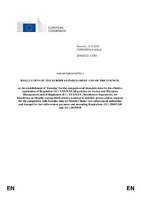Amended proposal for a REGULATION OF THE EUROPEAN PARLIAMENT AND OF THE COUNCILon the establishment of 'Eurodac' for the comparison of biometric data for the effective application of Regulation (EU) XXX/XXX [Regulation on Asylum and Migration Management] and of Regulation (EU) XXX/XXX [Resettlement Regulation], for identifying an illegally staying third-country national or stateless person and on requests for the comparison with Eurodac data by Member States' law enforcement authorities and Europol for law enforcement purposes and amending Regulations (EU) 2018/1240 and (EU) 2019/818

com document
Author
European Commission
Date
2020-09-23Subject headings
Immigration ; Migration and Asylum ; VariableGeometry ; Stakeholder consultations ; Fundamental rightsAbstract
In July 2019, European Commission President Ursula von der Leyen’s political guidelines announced a New Pact on Migration and Asylum, based on a comprehensive approach to external borders, asylum and return systems, the Schengen area of free movement, the external dimension of migration, legal migration and integration, to promote mutual trust among Member States.The Communication on a New Pact on Migration and Asylum, presented together with a set of legislative proposals, including this proposal amendingthe 2016 proposal for a recast Eurodac Regulation, represents a fresh start on migration. Based on the overarching principles of solidarity and a fair sharing of responsibility, the new Pact advocates integrated policy-making, bringing together policies in the areas of asylum, migration, returns, external border protection and relations with key third countries.The challenges of migration management, including those related to irregular arrivals and return, should not have to be dealt with by individual Member States alone, but by the EU as a whole. A European framework that can manage the interdependence between Member States’ policies and decisions is required. This framework must take into account the ever-changing realities of migration, which have meant increased complexity and an intensified need for coordination. Although the number of irregular arrivals to the Union has dropped by 92% since 2015, there are still a number of structural challenges that put Member States' asylum, reception and return systems under strain.
Number of pages
63p.Language
EnglishDescription
COM(2020) 614 final2016/0132 (COD)
Publisher
European CommissionPublisher place
BrusselsCollections
Related items
Showing items related by title, author, creator and subject.
-
Proposal for a Refulation of the European Parliament and of the Council on the European Maritime and Fisheries Fund [repealing Council Regulation (EC) No 1198/2006 and Council Regulation(EC) No 861/2006 and Council Regulation No XXX/2011 on integrated maritime policy
European Commission (European Commission, 2011-12-02) -
REGULATIONS: Commission delegated regulation (EU) No 1159/2013 of 12 July 2013 supplementing Regulation (EU) No 911/2010 of the European Parliament and of the Council on the European Earth monitoring programme (GMES) by establishing registration and licensing conditions for GMES users and defining criteria for restricting access to GMES dedicated data and GMES service information: (Text with EEA relevance): II (Non-legislative acts)
European Commission (Official Journal of the European Union, 2013-11-19) -
Progress report on implementation of the LIFE regulation and evaluation of the action by the Community relating to the environment ACE, MEDSPA, NORSPA, and ACNAT. Proposal for a Council Regulation (EC) amending Council Regulation (EEC) No 1973/92 establishing a financial instrument for the environment (LIFE).
Commision of the European Communities (European CommissionBrussels, 1995-04-12)The first stage of the Life instrument, which was created by Council Regulation (EEC) No 1973/921 and entered into force on 23 July 1992, comes to a close on 31 December 1995. Under that regulation the Commission undertook ...
